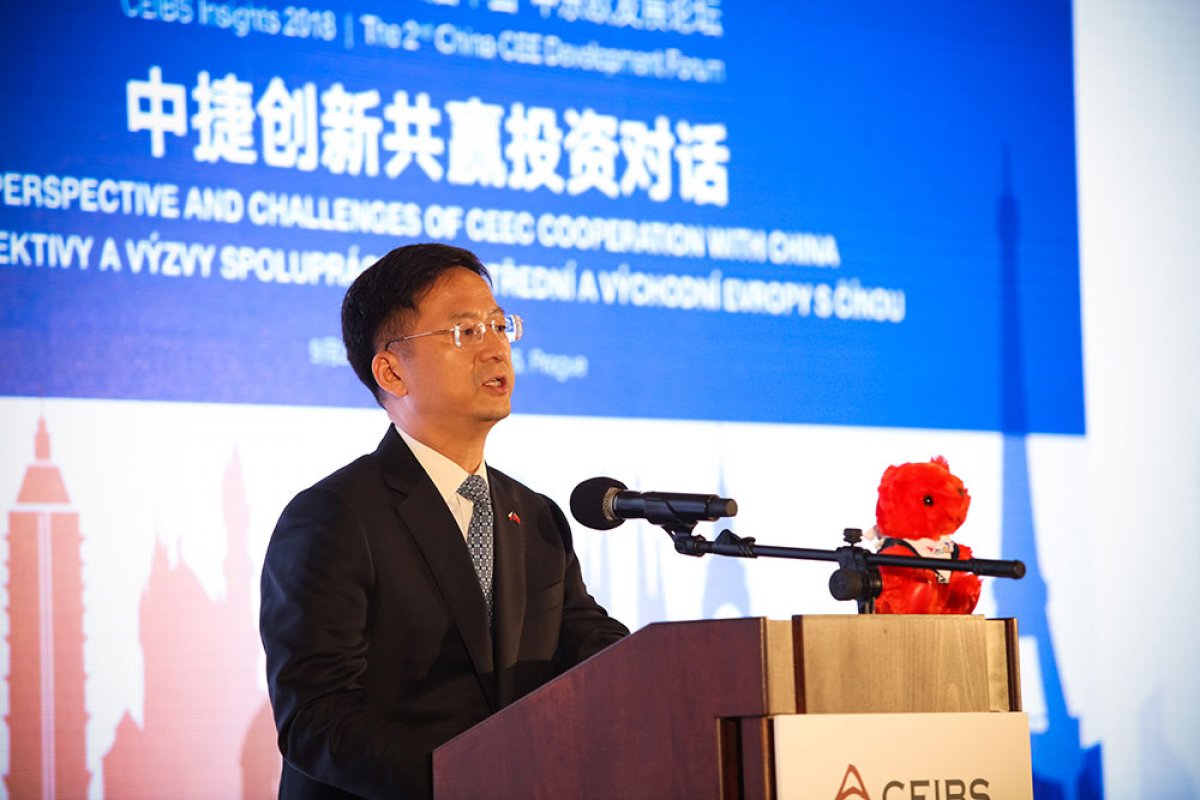An Era when Countries Compete to Stay Ahead
“Actually, I arrived in the Czech Republic two weeks ago so I am very happy to be here to attend this forum.
CEIBS itself is a crystallisation of the good relationship between China and Europe. As a Sino-European relationship is becoming more and more important, I am also seeing a better CEIBS in the future and I truly hope that CEIBS can continue to make contributions to the development of the relationship between China and the European Union. I would also like to wish this forum great success.
This forum is a very good platform for mutual understanding and collaboration. This can help European companies to better understand China’s development and the One Belt One Road initiative.
At the same time, Chinese entrepreneurs will get to know the EU situation better. As [Chinese President] Xi Jinping put it, history always gives people the opportunity to gain wisdom and the power to march forward in some special years. I think 2018 is just such a year, because it is the 40th anniversary of the reform and opening up. This also marks the 5th anniversary of the One Belt One Road strategy.
Forty years after reform and opening up, China has already become the second largest economy, the second biggest investor, and the biggest country in terms of foreign reserve. We are already the biggest trade partner to over 120 countries. Socialism with Chinese characteristics has entered a new era and China has, as a country, started a new journey.
So this is an era when countries compete to stay ahead, and the Czech Republic is no exception. As we speak, the country has had four consecutive years of economic growth, is performing very well on all major indicators, and ranks among the fastest growing EU countries.
Meanwhile, strong domestic demand, robust consumption and investment also kept the country’s debt ratio and unemployment rate the lowest among all EU countries. In this era, our two countries must adapt new concepts and a new mind-set and work closely together for common development. Traditional Chinese wisdom has it that one should do to others as what one would have done to him.
Five years after it was announced, the One Belt One Road initiative has become a Chinese solution for China to participate in global opening up and cooperation to improve economic governance worldwide, promote common prosperity, and build a community of shared future for the entire mankind.
The goods trade between China and the One Belt One Road countries already exceeded five trillion US dollars, FDI exceeded 60 billion US dollars, created 200,000 job opportunities, contributing to over tens of billions of US dollars in terms of tax revenue. Just last week, the EU promulgated its EU strategy on connecting the EU and Asia, championing comprehensive, sustainable and rural-based connectivity which echoes a critical goal of the One Belt, One Road initiative. Now the leaders of the EU and China have already forged a consensus to align the One Belt One Road strategy with the connectivity plan of EU.
We are deeply convinced that our joint efforts hereafter will translate into a stronger and a more robust Euro-Asia connectivity. The development of China will provide great opportunities for many countries in the world. We are also changing our economic model from growth-driven to quality-driven. This will boost more dynamics to the rest of the world.
This coming November, China will host the first China International Import Exhibition in Shanghai, to share development opportunities with businesses from across the world. [Czech] President Zeman would lead a business delegation to attend the CIIE. We truly hope that Czech companies could make the best use of this opportunity to promote export to China. Whether it is hosting the exhibit or participating in the exhibit, they are all supporting or embracing globalisation.
The world is undergoing profound changes: unilateralism, and trade protectionism are on the rise, exacerbated only by the tense trade relations between big countries arising from war as well as global safety uncertainties. China however has remained committed to its national policy of opening up, how to treat multilateralism and liberation, and continue to support economic globalisation.
As Xi Jinping has promised, China will further open its doors wider to the rest of the world to make the investment environment more attractive and to strengthen IP protection. We will not close our doors; we will open up further to the outside world. When I submitted my credentials to the Czech President, he made it very clear that he is on China’s side to support world trade and the free trade.
In recent years, there has been very good development of bilateral ties between China and the Czech Republic. Notably, in March 2016, President Xi visited the Czech Republic to upgrade the bilateral relationship to a strategic partnership. [In terms of the] One Belt One Road and the 16+1 cooperation, we have started to see the fruits of cooperation between China and the Czech Republic. First, bilateral investment has been growing very fast. According to statistics, new investment to the Czech Republic up to the end of 2017 was 390 million US dollars, and the Czech Republic accumulated investment of Czech2.7 billion US dollars. The actual paid out amount was 2.2 billion US dollars, and over 40 Chinese companies have made investments in the Czech Republic. We have also seen high-tech projects and high-value added projects taking root in China — many traditional industries like automotive machinery, white goods, and chemical companies are also building their R&D and service centres.
Second, bilateral trade ties have been growing steadily. According to statistics, at the end of 2017 bilateral trade was at 12.4 billion US dollars, with annual growth of 13%. The first half of this year’s bilateral trade volume hit 7 billion US dollars, a growth of 27% — especially the export to China has been growing very fast to ease the unbalanced trade relationship between China and the Czech Republic. Now, China is still the third largest trade partner to the Czech Republic, and the Czech Republic is China’s second largest trade partner in Central and Eastern Europe.
Sino-Czech trade accounts for 20% of China’s trade with the CEE’s 16 countries. On top of traditional trade, cross-border ecommerce has also been developing very fast. More and more Czech people started to buy goods and products on e-commerce websites. And, the infrastructure connectivity continues to improve for direct lines linked in Prague with Beijing, Shanghai. Chengdu and Xi’an have been opened, accounting for over half of the direct flights between Shanghai and the 16 Central Eastern European Countries.
The Czech Republic is also served by cargo links and some companies have already created their warehouse and logistic centres in the country. Multimodal infrastructure network for passengers and cargo transportation that can take care of both traditional trade and cross-border ecommerce is gradually taking shape, providing backing for the One Belt One Road strategy.
Of course, there has been significant progress in financial cooperation. Bank of China and ICBC have already set up branches in the Czech Republic. Bank of Communications have also applied to set up a branch here. There has also been discussion to create R&D settlement centres in the country. Prague is also a place for many financial institutions in China.
Fifth, there are more exchanges between people of the two countries. Both countries have signed high education diploma agreements, and also MoUs on joint R&D. The annual number of Chinese travellers visiting the Czech Republic has increased by 20%, and there were half a million people from China visiting the Czech Republic in 2017. Here, we found people in love with Mandarin, and there are more people doing research on the One Belt One Road initiative.
There are a lot of private and civic activities during the spring festivals, summer sports, and opportunities for exchange. At the same time, traditional Chinese hospitals are becoming more and more welcomed in the Czech Republic and Tong Ren Tang also established their clinic here.
Ladies and gentlemen, the enhancing of the strategic partnership between China and the Czech Republic on all fronts is deepening practical collaboration in all areas. This is not only for the wellbeing of the people from the two countries, but also the expectation from both their leadership and the people themselves.
In recent years, there has been a lot of collaboration between China and the Czech Republic. It is very important to us to find common interest points, and also to develop a new source of growth. This is both a challenge and an opportunity. Looking forward, as President Xi Jinping said, China is a big country with related responsibilities.
So China is more than willing to work together with the international community to bring about a stable, and bright future for the world in open collaboration. Especially with the trade protectionism being seen today, we should hold to free trade and make our contribution [to this effort]. Thank you very much.”

















